Defining and Framing Health Equity | Understanding Our Implicit Bias | Capacity Building through Partnerships Module | Building Community-Based and Effective Coalitions | Engaging Partners Effectively | Understanding Power | Resources
Community coalitions have a long-standing history in prevention movements. They allow us the opportunity to implement comprehensive and equitable, long-term solutions to address systemic problems. As a strategy to advance health equity, coalitions convene multi-sector partnerships that work to expand capacity, power, and resources to collectively implement strategies that lead to Policy, Systems, and Environmental (PSE) change. Coalitions are founded on a shared vision and values and have a defined purpose and objective.
This Coalition Building Toolkit provides guidance and tools for building effective and sustainable coalitions to advance and implement equitable tobacco prevention and control strategies and activities. This toolkit should be reviewed with a health equity lens. It is important that this lens not be an afterthought but a framework that is at the forefront of and leading the work.
Defining and Framing Health Equity
Health equity means that everyone has a fair and just opportunity to be healthy. This includes a fair and just distribution of social resources and social opportunity and requires removing obstacles to health such as poverty, discrimination, and their consequences, including powerlessness. (Braveman P, Arkin E, Orleans T, Proctor D, & Plough A, 2017; ASTHO, 2000)
Effective health equity strategies meaningfully involve many different partners from the beginning. Coalitions collaborate with community members and/or a wide variety of organizations to ensure that the voices of communities most impacted by the issue are centered and have decision-making power. Examples of these partnerships include:
- Local youth groups and youth-serving organizations
- Lesbian, gay, bisexual, transgender, and queer/questioning (LGBTQ+) support groups
- Behavioral health treatment centers
- Organizations serving active-duty military personnel and veterans
- Faith-based organizations
- Members of local tribal nations
- Other community groups working to achieve health equity
(Adapted from the CDC Partnerships in Tobacco Prevention and Control Best Practices User Guides)
Understanding Our Implicit Bias
It is important to understand that biases are not inherently bad. All humans have implicit biases and most people are unaware of their unconscious biases. Biologically, our brain creates neural pathways to help us quickly identify what is 'dangerous' and what is 'safe'; this is incredibly important for our survival as human beings. However, in our current context, we have been socialized to attach different racial and social groups to the pathway of 'dangerous' which in turn supports the dehumanization of these groups. According to John Powell and the Haas institute, we are wired to empathize and collaborate with our 'in-groups' (people who share a similar life experience with us) and distrust and conflict with 'out-groups' (people who are different from us or the groups that society has deemed as 'dangerous').
Understanding and examining one’s own beliefs are important when working with people affected by inequities, including tobacco-related disparities. Starting a process of self-reflection, known as cultural humility, is an important part of this. Cultural humility is a continual process of learning and self-awareness. You can practice cultural humility by:
- Taking a self-assessment to recognize your own values and biases
- Using mindfulness techniques to recognize their own thoughts and emotions and those of others
- Thinking about the culture and experiences of people from priority groups
- Forming partnerships with people who have lived experiences that match those of community members
- Learning about the community’s history, especially with commercial tobacco
- Avoiding stereotyping and consider that people from the same population may have different experiences and values
Working closely with partners who represent priority populations increases the likelihood that strategies focus on relevant issues, in turn being more equitable. Partners can help organize and contribute to focus groups, collect data for community assessments and review health communications messages. As respected members of the community, partners can also speak on behalf of the coalition about the impact of commercial tobacco use.
When we reflect and identify our biases, we are able to rewire our brain to prevent making assumptions or dangerous conclusions that support harmful and inequitable decision-making. This is a journey that is continuous and uncomfortable. However, it is necessary to ensure that we are working for a more equitable world for all of us.
For more resources and learnings about Health Equity, please refer to the Health Equity Hub.
(Adapted from the CDC Partnerships in Tobacco Prevention and Control Best Practices User Guides)
Capacity Building through Partnerships Module
This brief module focuses on the basics of effective coalitions and strategies to support coalition building.
Building Community-Based and Effective Coalitions
A coalition is not a random association of well-meaning individuals, it is a systematic collection of institutions and networks of people that are vested in a transparent shared interest. Building coalitions is not easy work. It takes effort to find and align individuals and/or institutions to support a collaborative and self-sustaining group.
Coalition coordinators are meant to do just that: coordinate members of the coalition to do the work of the group. It's important that the alliance is built in a way that members are committed to the coalition activities and that they see them beneficial to their work.
Simply put, a coalition is an alliance that builds shared power for collective action. It can involve any individuals and/or organizations, in any type of association or structure, for any length of time, as long as there is a shared purpose and goals. Coalitions allow us to crowdsource knowledge to increase collective capacity and build power that leads to structural changes. Positively impacts root causes of health inequity.
Coalitions offer many benefits, including opportunities to:
- Exchange knowledge, ideas, and strategies
- Share risks and responsibilities
- Build community concern and consensus for issues
- Engage in collective action that builds power
- Improve trust and communication among community sectors
- Mobilize diverse talents, resources, and strategies
Although coalitions are made up of members who are engaged at various levels, many coalitions have a core group of individuals or organizations that are already working on the issue at hand. It includes leaders in the community that either work on the issue of tobacco or with the Populations of Focus.
The benefits of a core group include:
- Providing support system to lead the effort of building a coalition and moving the work forward
- Identifying potential coalition members contacts from each person's network of relationships
- Increasing shared knowledge of the issue and the community
- Sharing tasks so all the work does not fall on the coordinator
Asset mapping is a systematic process to identify key individuals and/or organizations, and community strengths and resources. These are your community assets. Asset mapping is a visual and reflective process used to brainstorm the organizations/agencies within the community and identify who is doing work that aligns with the coalition's goals.
Community assets include:
- Community Leaders: Individuals in the community that neighbors turn to for information
- Associations of individuals: Neighborhood Associations and Block Clubs, church groups, Parent-Teacher Associations
- Private, public, and/or non-profit institution leaders in the community: local business owners, school principals, non-profit Executive Directors and/or community organizers
- Organizations/agencies that support the community: schools, hospitals, libraries, youth clubs (YMCAs, Boys and Girl Clubs), health centers, parks, churches, etc.
The table in Worksheet 3a of the Health Equity Planning Tool outlines many different sectors that can support this brainstorm. Asset mapping works best when done in collaboration with coalition members. Although the process can be adapted to the specific needs of the group, the general process is as follows:
- Define the community: Who are the stakeholders (community members most impacted by the issue)?
- Identify the current engagement: Who is already part of your core group/alliance and what is their current engagement? Are stakeholders currently involved with our coalition?
- Brainstorm the organizations/agencies in the community: What organizations/agencies are working to support positive outcomes in the community?
- Determine who is missing: Who are the leaders in the organizations/agencies needed at the table? How will the populations of focus be engaged?
- Establish next steps: Who are the individuals that should be prioritized for recruitment? Who within the coalition has established relationships with them? Refer to Worksheet 3b in the Health Equity Planning Tool to identify the next steps.
Coalitions should regularly update these lists. Keeping an updated inventory of community assets/stakeholders can support the alignment of efforts to support your coalition goals.
As a coalition coordinator, it is in your interest to bring powerful and committed individuals together. In being strategic with who you bring to the table, there is an opportunity to create a powerful and self-sustaining alliance. One-on-one conversations are a tool in building the relationships necessary to achieve such a goal.
Start with the people you know and set up one-on-ones with them.
- Who have you already been working with or have a positive relationship with?
- Who is on your supporter list that you haven’t been in touch with lately?
- Who can your Core Group connect you with?
When recruiting members to be part of the coalition, one-on-one conversions are our most important tool. A one-on-one conversation is an intentional conversation with a person. This is not a casual chat. The goal of a one-on-one conversation is to build a relationship with the person by understanding who that person is, what their “story” is, and to make possible connections.
Self-interest is a person's concern for personal priorities of health and safety, and those of the people that are connected to them (friends, family, neighbors). A person’s self-interest and how they might want to be involved in the coalition can be identified in a one-on-one. People act out of their self-interest, that is their motivation to act.
- Discover self-interest through powerful “what” and “why” questions
- You have been in the neighborhood a long time, how have you seen it change?
- As a parent, what are your concerns around vaping?
- Probe further with "why" questions
- Why are you concerned with that?
- Why is that important to you?
- Connect self-interest to next steps
- As we discussed, will you connect me to so-and-so? Do you need anything from me to make the connection?
- When we hold our next meeting, would you be interested in attending?
- Is it okay if I follow up with you about ***, add you to my supporter list, etc. (depending on the specifics of the conversation)?
- Don’t be discouraged if they say no. They might say they’re too busy right now. You can thank them for their time and check in a few months later.
Things to keep in mind during one-on-ones conversations:
- Active Listening
- Follow the 80/20 rule. Coordinators should spend most of the conversation listening, and should only be speaking 20% of the time. The person you're meeting with should be speaking 80% of the time.
- Use Appreciative Inquiry when asking questions
- Appreciative Inquiry (AI) seeks to engage people in self-determined change, based on the premise that every person has wisdom, and every system has strengths to offer.
- Evidence-based reasons to use Appreciative Inquiry:
- Solution-based approaches change the basic orientation from problem-focused to possibility-focused
- Focuses on turning the negative or problem into an opportunity
- Renewal of energy, hope, motivation, and commitment
- Increased curiosity
- Improved conflict resolution
- Evidence-based reasons to use Appreciative Inquiry:
- Appreciative Inquiry (AI) seeks to engage people in self-determined change, based on the premise that every person has wisdom, and every system has strengths to offer.
See here for additional guidance: One on one Guidance
People will want to engage in the coalition in different ways, depending on their skills and self-interest. Supporter lists are a tool to keep track of this information. Individuals can be identified for specific activities (e.g. letter to the editor, meetings with local leaders) by categorizing engagement levels with color-coding and/or a rating system. The more detailed the list, the more beneficial the list will be.
Supporter List Example:
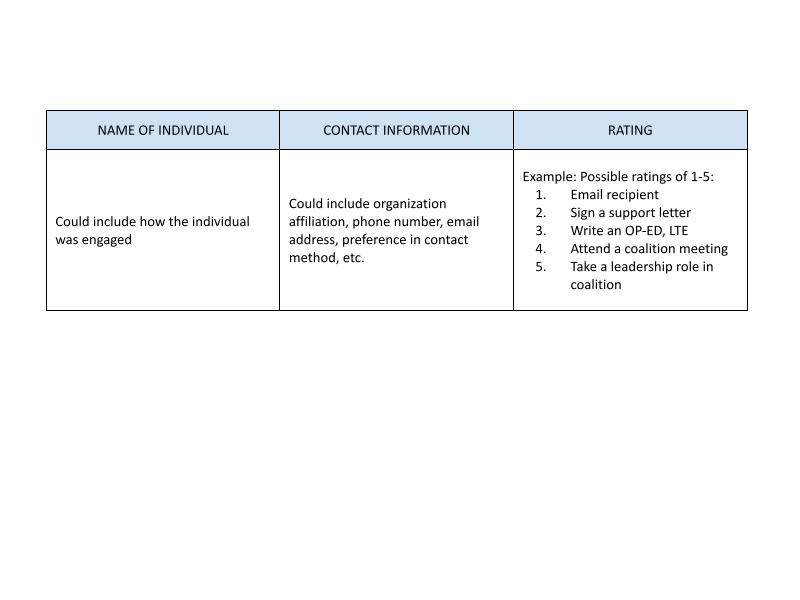
** Level of engagement of a person can change over time. Following up with individuals on your supporter list can result in someone wanting to be more involved than they already are.
The purpose of a coalition charter is to acknowledge, in writing, an understanding of and commitment to the coalition’s mission, activities, membership, roles and responsibilities, communication, and decision-making processes. The following guiding questions can support the development of a charter:
- What information can you already plug into the charter?
- What questions still need to be answered? How will this inform your team's action plan and objectives?
- How will you use a charter to build an inclusive coalition culture?
- Who is responsible for developing the charter?
- What is your charter timeline?
- Where will it live?
Charter Templates:
Clearly defined roles and expectations help partners contribute to tobacco control goals. Partners contribute most effectively when their roles match their strengths and fit the coalition's needs. Partners may be able to serve multiple roles, for example, planning a coalition event and speaking at a press conference. Offering a variety of roles also helps partners build new skills.
(Adapted from the CDC Partnerships in Tobacco Prevention and Control Best Practices User Guides)
Engaging Partners Effectively
(Adapted from the CDC Partnerships in Tobacco Prevention and Control Best Practices User Guides)
Equipping partners to work together effectively makes the time and resources they invest in the partnership worthwhile. Well-managed strategic partnerships and coalitions plan for how partners will contribute to goals and interact with other partners. These processes are important for all partnerships but can be especially critical for coalitions with many members. Successful partnerships have the following features:
- Clearly defined partner roles
- Effective meetings
- A process for making group decisions
- A system for communicating with partners
- Work groups to distribute tasks across larger partnerships
- Strategies for managing potential conflict
Partners use meetings to exchange information and ideas, make group decisions, share successes and setbacks, and ask questions. Regular meetings help partners stay on track and make progress toward goals. For some partnerships, meeting twice a year with frequent communication in between may be enough. Other partnerships, especially those with short timelines, may want to meet monthly or weekly.
If community members or youth are included as partners, it is important to schedule meetings when they can attend, such as evenings or weekends. Providing transportation or child care can also help increase involvement. Partners are busy professionals, so using meeting time wisely is important. When partners believe that meetings make good use of their time, they may be more likely to attend future meetings and events. Effective meetings have these features:
- A clear purpose
- A structured agenda
- A skilled leader
- Ground rules for participation
- Time for networking
- Follow-up communication about tasks and deadlines
A good meeting leader keeps participants focused and makes sure everyone has a voice. Throughout the meeting, the leader:
- Checks to make sure partners follow the agenda and stay on time
- Summarizes the meeting results
- Asks for input from people who have not spoken
- Protects people from personal attacks
- Encourages the group to revisit difficult issues if they cannot agree
Alternating who leads meetings can share power and build the capacity of partners without a tobacco control background. To learn more, check out these tools for effective coalition meetings.
A fair and transparent decision-making process helps build trust and prevents power from being concentrated among a few partners. Partners can set operating agreements such as discussing one issue at a time, giving everyone an equal right to be heard, and requiring majority support to take action. It is also important to establish a process for decisions that need to be made urgently, such as reviewing and approving materials.
Consensus building can help achieve broad support for big decisions like changing strategic direction, applying for a new grant, or hiring staff. To build consensus, discussion continues until everyone’s most important needs are met. For each member, parts of the agreement may not be ideal, but they can live with the outcome and will support the decision. Decisions made by consensus are more likely to be implemented successfully but may take longer to reach. Achieving consensus may be a new strategy for some partners, so training in group discussion, listening, and conflict resolution beforehand can help smooth the way to agreement.
Frequent communication connects partners to the coalition and to each other. It helps members stay up to date on progress toward goals, understand their responsibilities, and prepare for meetings. Communication can also increase member involvement and motivation. Information can be effectively shared through e-newsletters or websites.
Disagreements are a natural part of working together, especially in large partnerships. Partners may clash over strategic direction, different personalities, adding new partners, or allocating resources. But when conflict escalates, it can drain partners’ energy and lead to turnover, reluctance to conduct activities or recruitment challenges. Effective meetings, clear decision-making processes, and frequent communication can help avoid many sources of conflict. Coalitions can also reduce conflict by clearly defining roles and balancing different viewpoints.
Understanding Power
Power can be defined simply as the “ability to act”. It is the collective capacity of individuals, organizations and/or communities to take control of their circumstances, crowdsource intelligence and resources to align actions to achieve their own goals. In a power analysis, we can start to reflect about the potential opportunity we have as individuals and a collective to shift our current political, social, and environmental context.
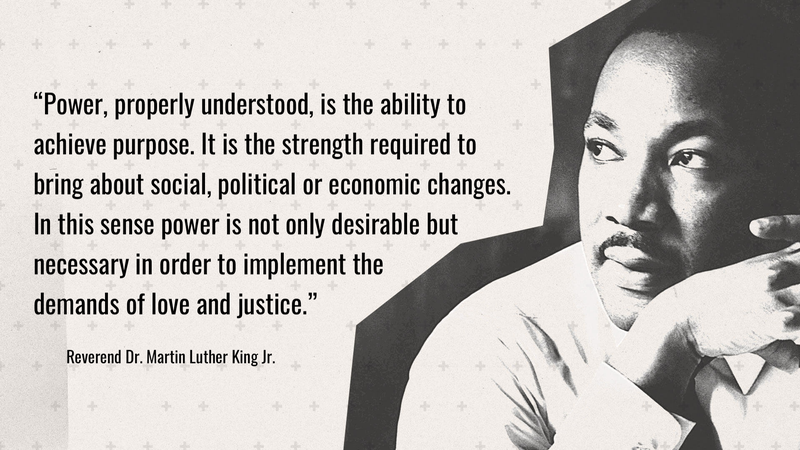
(Image adapted from the University of Nebraska - Lincoln, Martin Luther King, Junior Week Page)
In our current context, many individuals and communities have interacted with power by means of the political and economic institutions, where there is an inherent power-over and coercive relationship. This has shaped an unspoken assumption of unequal power relations that are inherently inevitable and unchangeable. However, as seen in the vast history of movement building, power and power relations, are socially constructed and therefore, changeable.
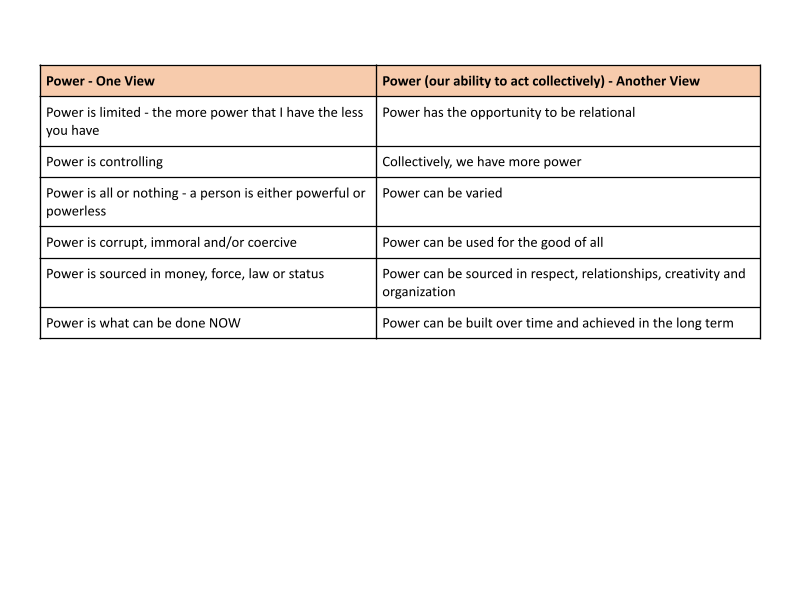
(Table adapted from Advancing Health Equity Key to Our Nation's Health Presentation by Jeanne Ayers, 2017)
(Adapted from Grassroots Policy Project, Strategic Practice - Power and Social Change)
The three areas where there is an opportunity to strengthen collective power are:
People
- The development of relationships, aligning self-interests with the collective interest. At that intersection, is the ability to build power to influence decision-makers.
- Possible Reflection Questions:
- How are we engaging and centering our Populations of Focus?
- What will it take to build a structure for shared leadership, and shared power?
- Possible Reflection Questions:
Resources
- The transformation of the current infrastructure to ensure equitable access to resources. This supports communities most impacted by inequities to lead the work.
- Possible Reflection Questions:
- What types of resources (physical, human, intellectual, financial) do we have access to?
- What risks should we be taking to lower barriers for Populations of Focus to access those resources?
- Possible Reflection Questions:
Narrative
- The identification of our historical and current context in order to shift the current dominant narrative. This is done by centering the stories of Populations of focus to align a transformational narrative to build public understanding and will.
- Possible Reflection Questions:
- What is the dominant narrative and who has shaped it?
- What beliefs and/or values are we trying to communicate as a collective?
- Whose stories are being lifted up and highlighted? Who is missing?
- Possible Reflection Questions:
(Adapted from Advancing Health Equity Key to Our Nation's Health Presentation by Jeanne Ayers, 2017)
Power mapping is a framework for problem-solving through relationship building and collective alignment. Power maps are a tool to visually represent and analyze the relationships between people, organizations, and institutions in relation to a specific issue and goal. They highlight the relationships that can be built and influenced to achieve the collective coalition goal.
Power Maps help us answer...
- Who are key potential allies in the community—individuals and/or organizations who are aligned with the coalition?
- Who is acting in opposition to the goal, and who are the individuals that we can influence?
- What are effective ways to communicate the coalition's goals?
Who should be involved in this process?
The power mapping process is an opportunity to crowdsource information and build a collective understanding of the relational power needed to achieve a goal. It is important to be intentional and strategic about who is in the room, including, people familiar with the issue and people working with the local community and/or who are directly impacted by the issue.
**The Asset map process can be a preliminary step and help support a power mapping process
Step 1: Create a goal
Maps can be done around a problem, a person, or an institution. Establish a specific goal for an effective process that highlights opportunities for change.
Questions to consider:
- Is this goal attainable?
- Are root causes being addressed?
- Are the Populations of Focus involved in this process?
Step 2: Identify individuals and institutions
Identify key decision-making individuals and institutions. Consider the decision maker's and the coalition's relationships and spheres of influence.
Questions to consider:
- Who is the individual and institution that have the power to make the decision?
- What are their spheres of influence? Who do they have relationships with?
- What are the coalition's spheres of influence? What relationships does the coalition have?
- Is there anyone working in direct opposition? Is there an opportunity to build relationships to shift beliefs?
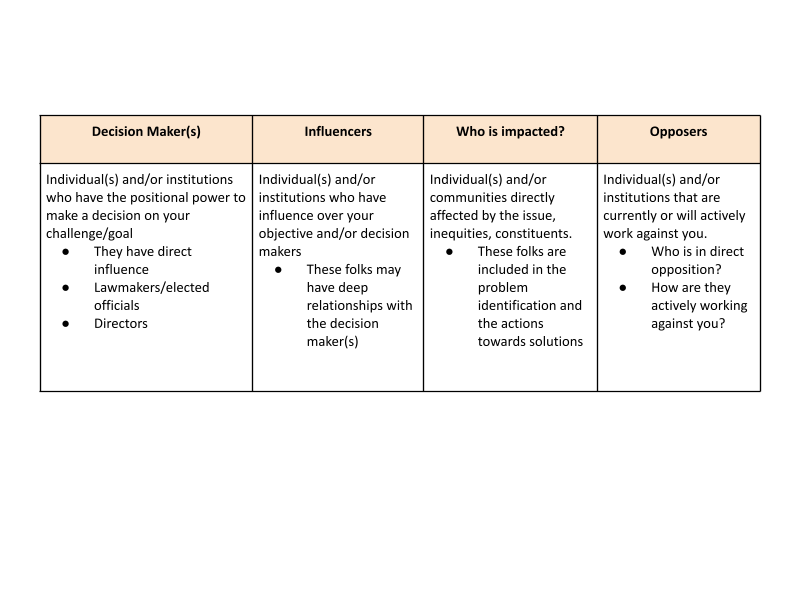
Step 3: Map individuals and institutions
Map the individuals and institutions identified in Step 2 on a four-quadrant power map. Focus on the positions of the individuals and institutions relative to each other rather than the exact placement on the map.
- Start with individuals in the coalition
- Next, map the decision-makers
- After that, map the decision maker's spheres of influence
- Next, map the coalition's spheres of influence
- Finally, map the opposition
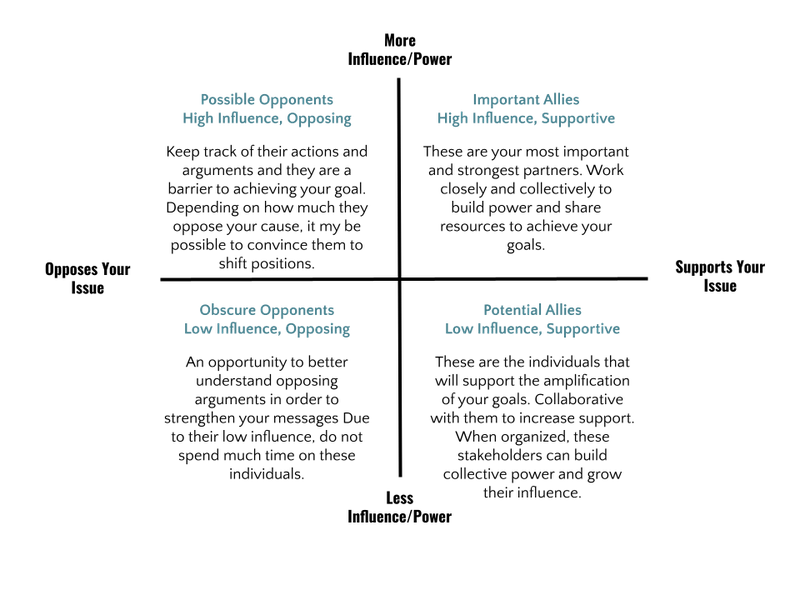
Step 4: Draw relational lines
Determine the relationships between the individuals and institutions mapped in Step 3. Draw lines to connect them. Some individuals and institutions will have many connections while others may not. A decision-maker may not have many relational lines running to them, nonetheless, they are critical and hold a lot of power and influence to achieve the goal.
Write down questions that come up or gaps in knowledge that need further research. This will be important information when thinking about the next steps.
Step 5: Prioritize relationships
Circle the individuals and institutions the coalition would like to build relationships with. Prioritize the individuals with the most power and influence (y-axis) as well as the individuals with the most relational lines connected to them.
Questions to consider:
- Who are the individuals and institutions with the most influence and what are their connections to the decision-makers?
- What relationships (one-on-ones) is the coalition going to prioritize?
- What is the coalition's collective power at this moment? How will the prioritized relationships help build the power of the coalition?
- Was this process exhaustive? Are there any lingering thoughts, individuals, institutions, and relationships that were not mapped?
- What questions and gaps came up? What information is needed to develop the next steps?
Step 6: Establish Next Steps
Generate the next steps the coalition will take. Strategies will emerge at every step of the power mapping process, take note of them for this step. Ensure that there is consensus among the coalition and that there is a shared responsibility for the next steps.
Resources
Use the resources here to fine-tune and shape your coalition.
- Sample Coalition Structure
- Coalition By-Law Examples (CAHL , Southwest Alliance , and W3TFL ).
- Learn some ins and outs with the Effectively Convening Your Coalition Tip Sheet.
- One on One Packet - NYC Organizing Support Center
- One-on-One Worksheet
- Sector Planning and Engagement Pyramid
- Coalition Member Engagement Worksheet
- Utilize current members' networks as a way to recruit new members: Circle of Influence Exercise.
- Collect info from your members through a Coalition Membership Application (WAATPN).
- Distribute orientation information in a new member packet - New Member Packet Sample.
- Keep track of everyone with this Supporter List Template.
- Hold a Community Event to identify new supporters.
- Get some advice from the Managing and Engaging Your Coalition List Tip Sheet.
- Send a Coalition Feedback Postcard (South Central) to assist in engagement.
- Get tips on How to Conduct a Community Appreciation Event to say thanks.
- Utilize a survey to involve coalition members in decision-making.
Keep in touch with your members through consistent communication, whether it be by newsletter, website, or social media.
Find organization's websites and social media links in the Connect section.
- Newsletters. Send to coalition or distribute the community. Check out these e-communication tips and best practices.
- Websites. Share news, contact info, forms, calendars, etc. all in one place.
- Social media. Update your group quickly and reach into their social networks. Like or follow fellow tobacco coalitions to get ideas for content.



